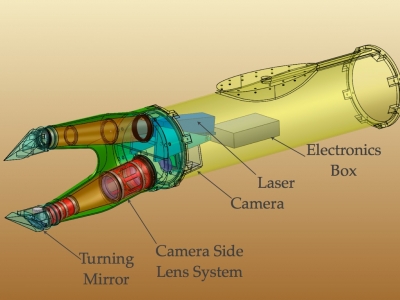Delineating the Sharp Edges of Clouds, Down to the Micrometer
Published: 26 October 2015

Science article shares research supported by the ARM Facility
The way that clouds mix with the air around them has been a source of controversy for decades, influencing models from cloud to climate scales and sending scientists searching for an ever-more exacting way to take measurements inside clouds. Now research supported in part by the Atmospheric Radiation Measurement (ARM) Climate Research Facility is giving scientists the ability to settle the matter.
The study by a team of scientists from Michigan Technological University, Germany’s Mainz University, and the National Center for Atmospheric Research (NCAR) was reported in the October 1 edition of Science magazine. The findings show that the uneven, or inhomogeneous, mixing inside clouds is contrary to what most models assume.
Sharp Boundaries
“What we discovered is that sharp boundaries form on clouds as dry air completely evaporates some water drops and leaves others unscathed,” said Raymond Shaw, physics professor from Michigan Tech, who led the study.
“When clouds mix with dry air from their surroundings, one might guess that all droplets will evaporate just a little bit until the air becomes saturated,” he said. “But we observed instead that a subset of droplets evaporates completely, leaving the remaining ones almost unchanged. The differences in how the liquid water in a cloud is divided into droplets, in a few large drops or a lot of small ones, influence how much sunlight makes it through the clouds into the lower atmosphere and how clouds reflect, buffer, or trap heat.”
Accurately Measure Liquid Droplets

It can be challenging to accurately measure liquid droplets in clouds, particularly when those droplets are the size of micrometers, hundreds of times smaller than a grain of sand on the beach. Using the Holographic Detector for Clouds or HOLODEC, a three-dimensional imaging system mounted in an airborne laboratory, scientists can take measurements directly inside clouds. The holograms provide an unprecedented view of the three-dimensional distributions of droplets at centimeter-to-micrometer scales within the cloud.
“Our results in this study wouldn’t have been possible without the assistance of the ARM Facility to improve instrument performance for fieldwork,” said Shaw.
Reference: Beals M, J Fugal, R Shaw, J Lu, S Spuler, and J Stith. 2015. “Holographic measurements of inhomogeneous cloud mixing at the centimeter scale.” Science 350(6256):87-90. doi:10.1126/science.aab0751.
# # #
The ARM Climate Research Facility is a national scientific user facility funded through the U.S. Department of Energy’s Office of Science. The ARM Facility is operated by nine Department of Energy national laboratories.
The ARM Climate Research Facility is a DOE Office of Science user facility. The ARM Facility is operated by nine DOE national laboratories, including .
Keep up with the Atmospheric Observer
Updates on ARM news, events, and opportunities delivered to your inbox
ARM User Profile
ARM welcomes users from all institutions and nations. A free ARM user account is needed to access ARM data.


















